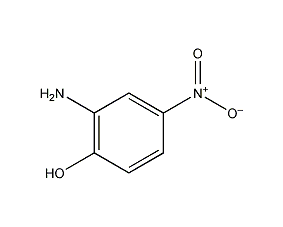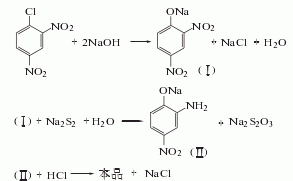
Structural formula
| Business number | 02G1 |
|---|---|
| Molecular formula | C6H6N2O3 |
| Molecular weight | 154.12 |
| label |
p-nitro-o-aminophenol, 4-nitro-2-aminophenol, 2-hydroxy-5-nitroaniline, 4-nitro-2-aminophenol, 4-nitro-o-aminophenol, P-nitro-o-aminophenol, 2-Hydroxy-5-nitroaniline, 4-Nitro-2-aminophenol, 2-Hydroxy-5-nitroaniline, Aromatic nitrogen-containing compounds and their derivatives |
Numbering system
CAS number:99-57-0
MDL number:MFCD00007695
EINECS number:202-767-9
RTECS number:SJ6300000
BRN number:776533
PubChem number:24846232
Physical property data
1. Properties: Brown-yellow or orange flaky crystals, industrial products are yellow-brown crystalline powder.
2. Density (g/mL, 25/4℃): Undetermined
3. Relative vapor density (g/mL, air=1): Undetermined
4. Melting point (ºC): 142~143, 176~177, 195~198 (decomposition)
5. Boiling point (ºC, normal pressure): Undetermined
6. Boiling point (ºC, 5.2kPa): Undetermined
7. Refractive index: Undetermined
8. Flash point (ºC): Undetermined
9. Specific rotation (º): Undetermined
10. Autoignition point or ignition temperature (ºC): Undetermined
11. Vapor pressure (kPa, 25ºC): Undetermined
12. Saturated vapor pressure (kPa, 60ºC): Undetermined
13. Heat of combustion (KJ/mol): Undetermined
14. Critical temperature (ºC): Undetermined
15. Critical pressure (KPa): Undetermined
16. Log value of oil-water (octanol/water) partition coefficient: Undetermined
17. Explosion upper limit (%, V/V): Undetermined
18. Explosion lower limit (%, V/V): Undetermined
19. Solubility: Easily soluble in ethanol, soluble in ether, acetic acid, methanol and hot benzene, slightly soluble in water.
Toxicological data
1. Skin/eye irritation: Standard Dresser test: rabbit eye contact, 100mg/24HREACTION SEVERITY, moderate reaction; 2. Acute toxicity: rat oral LD50: 2400mg/kg; rat peritoneal cavity LD50: 246mg/kg ; Mouse oral LD50: 850mg/kg; Mouse peritoneal cavity LD50: 143mg/kg; 3. Other multiple dose toxicity: Rat oral TDLo: 13750mg/kg/15D-I; Rat oral TDLo: 32500mg /kg/13W-I; Mouse oral TDLo: 13750mg/kg/15D-I; Mouse oral TDLo: 65mg/kg/13W-I; 4. Chronic toxicity/carcinogenicity: Rat oral TDLo: 64375mg /kg/2Y-C; 5. Mutagenicity: Mutant microorganism test: bacteria-Salmonella typhimurium, 20μg/plate; Mutant microorganism test: bacteria-Salmonella typhimurium, 100μg/plate; Phage inhibition test: bacteria-E. coli : 100mmol/L; Cell production analysis test: hamster ovary, 249mg/L; Sister chromatid exchange test: hamster ovary, 5mg/L;
Ecological data
This substance is harmful to the environment, and special attention should be paid to the pollution of water bodies.
Molecular structure data
1. Molar refractive index: 38.91
2. Molar volume (cm3/mol): 101.9
3. Isotonic specific volume (90.2K ): 303.6
4. Surface tension (dyne/cm): 78.5
5. Dielectric constant:
6. Dipole moment (10-24cm3):
7. Polarizability: 15.42
Compute chemical data
1. Reference value for hydrophobic parameter calculation (XlogP): None
2. Number of hydrogen bond donors: 2
3. Number of hydrogen bond acceptors: 4
4. Number of rotatable chemical bonds: 0
5. Number of tautomers: 5
6. Topological molecule polar surface area 92.1
7. Number of heavy atoms: 11
8. Surface charge: 0
9. Complexity: 156
10. Number of isotope atoms: 0
11. Determine the number of atomic stereocenters: 0
12. Uncertain number of atomic stereocenters: 0
13. Determine the number of chemical bond stereocenters: 0
14. Number of uncertain chemical bond stereocenters: 0
15. Number of covalent bond units: 1
Properties and stability
1. Avoid light. Avoid contact with strong oxidants, acid anhydrides, and acid chlorides.
2. Toxic. Harmful if inhaled, taken orally or in contact with skin. Irritant to eyes, respiratory system and skin. Detailed toxicity has not been reported. Toxicity and protection methods can be found in Nitrobenzene and Phenol.
Storage method
1. Store in a cool, ventilated warehouse. Keep away from fire and heat sources. Protect from direct sunlight. The packaging is sealed. They should be stored separately from oxidants, acid anhydrides and acid chlorides, and avoid mixed storage. Equipped with the appropriate variety and quantity of fire equipment. Suitable materials should be available in the storage area to contain spills. 2. Pack in iron drums lined with plastic bags. 50kg per barrel. Store in a dry, ventilated place, away from sunlight, heat and moisture. According to toxic chemicals regulations.
Synthesis method
Prepared from the hydrolysis of 2,4-dinitrochlorobenzene and partial reduction with sodium polysulfide. Raw material consumption quota: 2,4-dinitrochlorobenzene (industrial product) 2100kg/t, liquid alkali (40%) 2050kg/t, sodium polysulfide (100%) 700kg/t, hydrochloric acid (37%) 150kg/t .

p>
Purpose
1. Organic synthesis. Dye synthesis.
2. Intermediates for dyes and pharmaceuticals. Used to prepare acid medium brown RH, acid medium green 3G, neutral black BL, BRL, BGL, neutral brown RL, leather spray yellow GL, leather spray red GL, leather spray black RL, solvent red KL, etc.

 微信扫一扫打赏
微信扫一扫打赏

